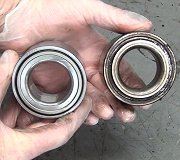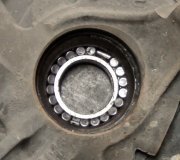You made a dandy observation of the noise changing when making slight steering changes, as in when changing lanes, and you are correct, the noise gets louder when steering away from the noisy bearing because more weight transfers onto it. There are two additional points of interest. The first is this applies to the pressed-in bearings like your car uses, and not as much for the bolt-on bearing assemblies. The second concern is this clue can be misleading. Due to how noise can transfer through the body, it is not uncommon for a noisy left bearing to sound like the noise is coming from the right side. This too applies more to the bolt-on bearings, but the good news there is the old bearing can be installed on the other side. I have had it happen to me with the pressed-in bearings, but those can only be removed by destroying them, so if the wrong one is replaced, you have to buy another one for the other side. They are very inexpensive, but it is the extra time needed to replace them that is costly.
It sounds possible the axle nut was torqued improperly, but the mechanic should have noticed the noise was still there on the test drive. Regardless, return to the same shop, explain the same noise is still there, and give them the opportunity to correct their mistakes. Ask to be allowed to talk with the mechanic when the car is on the hoist and is being inspected, then do the test I described where you spin the wheel and feel for the vibration in the coil spring.
If further inspection shows the left bearing is noisy, the issue then is who diagnosed the right one as being bad. Very often we read about a customer who diagnosed the cause of a problem by them self or with friends, then asked the mechanic to perform a specific repair. If the diagnosis turns out to be wrong, the customer got the service they requested, so they are obligated to pay for it. When the mechanic did the diagnosis and recommended a repair, there can be a gray area as to what to do if that diagnosis was wrong. Obviously when we see a sloppy ball joint or broken tire belt, it is easy to know those must be replaced, but with elusive noises, ambiguous diagnostic fault codes, and especially intermittent electrical problems, there can be no clear way to know what the cause is without time-consuming and expensive diagnosis, or heaven-forbid, the dreaded, ineffective, trial and error random parts replacement.
When the diagnosis is difficult or you are not getting the results you are paying for, the first step is to verify you are providing the most detailed clues as possible. This is where a good service writer at the larger shops is supposed to help the mechanic do his job as effectively as possible. It is not their job to start the diagnosis by entering such things on the repair order as, "check for broken tire belt", or "inspect ball joints". They can start the mechanic down the wrong road by listing those things they were told by the customer. Instead, "thumping and steering wheel shimmy", and "clunking in front end when driving over bumps" are the better symptoms to enter. That lets the mechanic head straight for the most likely suspects without getting sidetracked by what the service writer thinks might be wrong. We can also run into problems when we become fixated on what we found to be broken or worn out, but neglect to complete the inspection, then overlook other parts that are also worn. When a tie rod end breaks on a Ford car, for example, the other one is just as old and just as worn, but they often get overlooked, resulting in the "same" noise, then failure, a few weeks later.
In the case of noises, it is appropriate to ask for the mechanic to go with you on a short test drive so you can point out the noise and any related clues or observations. Be clear that noise must be gone for the repair to be considered completed. The mechanic should be able to suggest possible causes and in some cases, multiple methods of repair, but do not hold him to dollar amounts. If he guesses too low, he may be inclined to neglect important items in an attempt to stay under that amount. If he guesses too high, we have all run into people who incorrectly assume we cut corners involving their safety or the repair's reliability if the final bill is considerably lower than the guess. The mechanic's job is to identify the needed repairs, and he involves the parts department where they calculate the cost of the parts. The service writer takes all of that to calculate a more accurate repair estimate.
You might be allowed to ride along on the final test drive when the mechanic verifies the repairs, but most of the time, since time is money to the mechanic and the business, that may take place before they can find you. Or, ... In some cases the mechanic will not know if the problem is solved yet. This happened to me quite often with alignments. Some people would come in with mismatched tires, sagged springs, or body damage, and expect me to make the car not pull to one side on a straight road. Those things had to be offset by adjustments that were not "in specs", and were usually a trial and error affair. It could take two or three test drives before I thought the customer would be happy. Once I was satisfied, that was the last test drive, so the customer would not know he was satisfied until he paid for the repair and drove the car himself. At that point, if he still was not satisfied, that could have been avoided by refusing to do the alignment until matched tires were installed or the springs were replaced. As long as I am on this off-topic, understand we prefer to align cars with the old tires so we can "read" the wear patterns to insure we're correcting any related issues. The proper thing to do then is explain to the owner the alignment was adjusted to specs, and any pulling to one side will be gone once they install new tires.
As a last resort, there is a tool called the "chassis ear" that is designed just for this type of problem. It is a set of six microphones, a switch box, and headphones. You attach the microphones to suspect parts, then drive around while listening and switching between the microphones to narrow down where the noise is originating from. Be aware a lot of mechanics have never seen or even heard of this tool. Suspension and alignment specialists use them for locating causes of squeaks, clunks, and rattles. The original model used all wired microphones. There are newer models that use some wireless mics. You might find this tool at an auto parts store that rents or borrows tools. The guys who drive the tool trucks and visit each repair shop once a week have them too or can get them. You can even find them on Amazon for a much lower price.
Wednesday, February 7th, 2018 AT 3:08 PM



